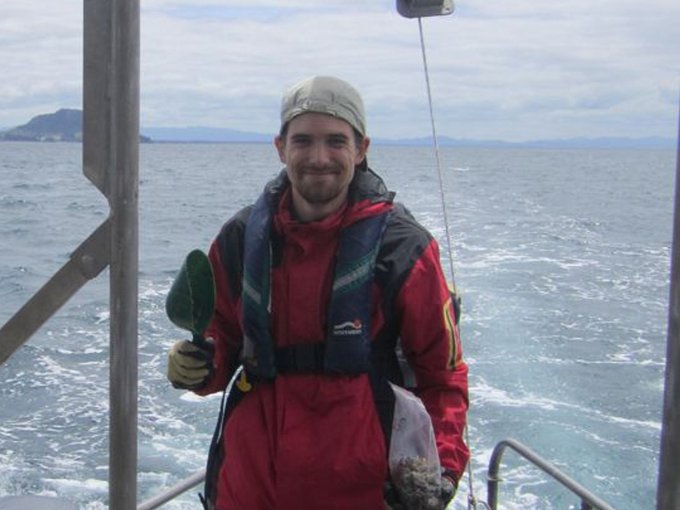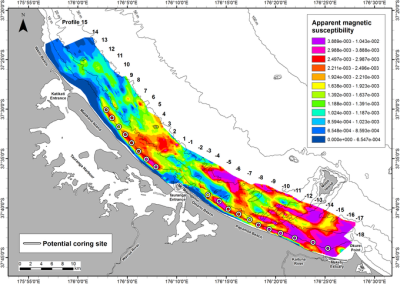Page path:
- Home
- ...
- INTERCOAST
- Latest News
- Archiv
- News 2015
- 03-03-2015 The current state... - A report by T...
- The current state of IC 8 - a report by Tobias Kulgemeyer
INTERCOAST
The current state of IC 8 - a report by Tobias Kulgemeyer
The state of IC8: Coming publications and planning of new coring campaign in Bay of Plenty
Two publications are prepared for publication within this year by INTERCOAST project IC8_II candidate Tobias Kulgemeyer. Furthermore, a new coring campaign in the Bay of Plenty is currently being planned for early 2015. This survey will provide further insight into the development of magnetite enriched sediments in the coastal zone – intricate features, whose analysis is the connection of the previous, current and future phases of IC8.
The existence of coast-parallel magnetite enrichments was one of the key results of the thesis of Firoz Badesab during the first phase of INTERCOAST. Through the environmental magnetic analysis of surficial sediment samples, elongated structures could be described along the coastline of Matakana Island, and first ideas about the formation mechanisms have been developed (Badesab et al., 2012).
The existence of coast-parallel magnetite enrichments was one of the key results of the thesis of Firoz Badesab during the first phase of INTERCOAST. Through the environmental magnetic analysis of surficial sediment samples, elongated structures could be described along the coastline of Matakana Island, and first ideas about the formation mechanisms have been developed (Badesab et al., 2012).
The existence of coast-parallel magnetite enrichments was one of the key results of the thesis of Firoz Badesab during the first phase of INTERCOAST. Through the environmental magnetic analysis of surficial sediment samples, elongated structures could be described along the coastline of Matakana Island, and first ideas about the formation mechanisms have been developed (Badesab et al., 2012).
These findings provided the basis for the deployment of the benthic profiler NERIDIS III in November 2012 (Fig. 1), which had been recently developed at University of Bremen/MARUM. Using a novel controlled-source electromagnetic sensor (CSEM) specifically adapted for the marine realm, NERIDIS was able to gather highly resolved data about the electric conductivity and magnetic susceptibility of the seafloor, a parameter that is directly linked to the concentration of magnetic heavy minerals in the sediment. Furthermore, a mounted camera system allowed for the visual examination of the local lithofacies – information, that proved invaluable during a sampling campaign in late 2013 (Fig. 2).
The results of the NERIDIS campaign and the subsequent sediment sampling survey will be published later this year in two separate journal papers by IC8_II student Tobias Kulgemeyer, who is at the moment on a research stay at the University of Waikato. The first of these papers is based on combined granulometrical, mineralogical, photographic and acoustic datasets.
These findings provided the basis for the deployment of the benthic profiler NERIDIS III in November 2012 (Fig. 1), which had been recently developed at University of Bremen/MARUM. Using a novel controlled-source electromagnetic sensor (CSEM) specifically adapted for the marine realm, NERIDIS was able to gather highly resolved data about the electric conductivity and magnetic susceptibility of the seafloor, a parameter that is directly linked to the concentration of magnetic heavy minerals in the sediment. Furthermore, a mounted camera system allowed for the visual examination of the local lithofacies – information, that proved invaluable during a sampling campaign in late 2013 (Fig. 2).
The results of the NERIDIS campaign and the subsequent sediment sampling survey will be published later this year in two separate journal papers by IC8_II student Tobias Kulgemeyer, who is at the moment on a research stay at the University of Waikato. The first of these papers is based on combined granulometrical, mineralogical, photographic and acoustic datasets.

Figure 1: The benthic profiler NERIDIS III during a survey in the Bay of Plenty in 2012.

Figure 2: IC8_II candidate Tobias Kulgemeyer during a sampling campaign in the Bay of Plenty in 2013
It provides unique and highly detailed insight into bedforms, lithofacies distribution and sediment transport pathways in a complex coastal system. This publication is currently under final revision by our colleagues in Hamilton and is expected to be submitted to a journal within the current semester.

Figure 3: Apparent magnetic susceptibility in the Bay of Plenty, interpolated from data obtained by NERIDIS III. Iron oxide enrichments are characterized by a high susceptibility. Potential coring sites for a survey planned for early 2015 are located along coast-parallel structures in a water depth of 10 m.
All data regarding the electro- and environmental magnetic view of the Bay of Plenty, including detailed maps of heavy mineral enrichment structures, will be part of the following second publication. While the analysis of the EM data is mostly finished, additional information from laboratory experiments is getting examined at the moment. This will allow for a detailed description of the origin and transport behavior of magnetic heavy minerals in the Bay of Plenty coastal system.
The next step will be the jump from map-based two-dimensional information to a three-dimensional view of heavy mineral enrichments. For this, a 1-2 day long survey aiming for the recovery of ca. 0.5 m long sediment cores along a coast-parallel enrichment structure is currently being planned (Fig. 3). The data will
The next step will be the jump from map-based two-dimensional information to a three-dimensional view of heavy mineral enrichments. For this, a 1-2 day long survey aiming for the recovery of ca. 0.5 m long sediment cores along a coast-parallel enrichment structure is currently being planned (Fig. 3). The data will
provide the basis for a numerical model, which is expected to provide further insight into the formation process. This work will be the final chapter of IC8_II; and the first chapter of future IC8_III, which will continue to investigate the formation and variation of heavy mineral enrichments under controlled conditions in laboratory studies.
References
Badesab, F., von Dobeneck T., Bryan, K.R., Müller, H., Briggs, R.M., Frederichs, T., Kwoll, E. (2012): Formation of magnetite-enriched zones in and offshore of a mesotidal estuarine lagoon: An environmental magnetic study of Tauranga Harbour and Bay of Plenty, New Zealand – Geochemistry, Geophysics, Geosystems, Vol. 13, Q06012, doi:10.1029/2012GC004125.
References
Badesab, F., von Dobeneck T., Bryan, K.R., Müller, H., Briggs, R.M., Frederichs, T., Kwoll, E. (2012): Formation of magnetite-enriched zones in and offshore of a mesotidal estuarine lagoon: An environmental magnetic study of Tauranga Harbour and Bay of Plenty, New Zealand – Geochemistry, Geophysics, Geosystems, Vol. 13, Q06012, doi:10.1029/2012GC004125.


